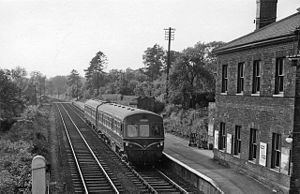British Rail Metro-Cammell Lightweight
This article needs additional citations for verification. (September 2022) |
| British Rail Metro-Cammell Lightweight | |
|---|---|
 An Eastern Region set at Brundall | |
| In service | 1955–1981 |
| Manufacturer | Metropolitan Cammell |
| Scrapped | 1967–1969, 1981 |
| Number built | 36 sets (72 cars) |
| Number scrapped | All |
| Formation | 2 car sets: DMBS-DTSL or DMBS-DTCL |
| Capacity | DMBS: 57 or 53 second class seats DTSL: 72 second class DTCL: 12 first and 53 second class |
| Operators | British Rail |
| Specifications | |
| Train length | 114 ft 0 in (34.75 m) |
| Car length | 57 ft 0 in (17.37 m) |
| Width | 9 ft 3 in (2.82 m) |
| Weight | DMBS: 31 long tons 10 cwt (70,500 lb or 32,000 kg) DTSL: 25 long tons 0 cwt (56,000 lb or 25,000 kg) |
| Prime mover(s) | Two BUT (AEC) 6-cylinder diesels |
| Power output | 150 hp (112 kW) each engine |
| Transmission | Mechanical: 4-speed epicyclic gearbox |
| Braking system(s) | Vacuum |
| Track gauge | 4 ft 8+1⁄2 in (1,435 mm) |
In 1955, Metropolitan Cammell produced its first lightweight diesel multiple units, the prototypes of what were to become British Rail's most successful and longest-lived First Generation DMU type, the Class 101.
Operations
[edit]The seven London Midland Region sets (formed DMBS + DTCL) were used on the Bury-Bacup line services, while the other sets (formed DMBS + DTSL) were all allocated to the Eastern Region. These sets were used on a variety of lines in East Anglia as well as the (then) non-electrified lines in Essex (Romford-Upminster and Wickford-Southminster branches).
A unit consisting of 79066 and 79282 worked the last passenger service on the Aldeburgh Branch Line in 1966.[1]
Withdrawal
[edit]They proved to be very successful, but with line closures continuing through the 1960s, including many in East Anglia where the type was first used, their non-standard coupling arrangements left them prone to early withdrawal, which took place during 1967–1969.
Departmental use
[edit]All were scrapped following withdrawal, except two (79047 + 79053), which were taken into departmental (non-revenue earning) service as 975018 + 975019. They were used at the Railway Technical Centre in Derby as Laboratory 21: Plasma Torch Research. When this extended life was complete, they too were scrapped, in 1981.
Fleet details
[edit]| Lot No. | Type | Diagram | Qty | Fleet numbers | Notes |
|---|---|---|---|---|---|
| 30190 | Driving Motor Brake Second (DMBS) | 591 | 29 | E79047–79075 | 56 seats |
| 30190 | Driving Motor Brake Second (DMBS) | 592 | 7 | M79076–79082 | 52 seats |
| 30191 | Driving Trailer Second with Lavatory (DTSL) | 593 | 29 | E79263–79291 | 72 seats |
| 30191 | Driving Trailer Composite with Lavatory (DTCL) | 594 | 7 | M79626–79632 | 12 first 53-second |
References
[edit]- ^ Great Eastern Journal No 64 (Great Eastern Railway Society)
